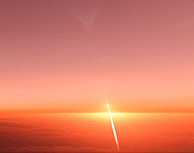
OPOD
What's New
Rays & Shadows
Water Droplets
Rainbows
Ice Halos
Contents
Crystals
Frequent Halos
Infrequent Halos
Multiple Displays
Other Worlds
Mars
Jupiter
Saturn
Observing Halos
HaloSim
High Atmosphere
Links & Resources
Search - Index
123456789012345678
| Saturn |
|
||||||||||||||||
| Saturn,
like Jupiter, is thought to have three main cloud layers. They lie
much deeper down in its atmosphere with the pressure already 0.5-1
bar at the uppermost ammonia-ice crystal haze and cirrus layer. An
intermediate level of ammonium hydrosulfide is 60 km (37 miles) below
that. Water-ice and water droplet clouds are yet another 90 km deeper. Titan, Saturn's largest moon, could also be a halo candidate. Models of its hazy atmosphere predict methane-ice clouds at its tropopause 40 km above the surface where the temperature is about 73 K (-200 Celsius). More about its atmosphere should be learned when the European Huygens probe descends through it in December 2004. |
Circular halos produced by three crystal forms of ammonia (top) and water-ice (below). |



